Top Takeaways and Key Concepts
→ Master your short game to dramatically lower scores and boost confidence.
→ Practice chipping and pitching regularly to improve control and accuracy around the green.
→ Develop consistent putting habits using proper stance, focus, and smooth follow-through.
→ Adapt your shots to different course conditions and lies for better recovery play.
→ Enjoy steady improvement by focusing on patience, progress, and fun each round.
Summary of This Article
The short game is where golfers truly shave strokes and gain confidence. By focusing on chipping, pitching, and putting, players build consistency and control under pressure. This guide encourages practicing smart techniques, adjusting for conditions, and maintaining a positive mindset—turning each round into a more confident, enjoyable, and rewarding experience.
Video Summary
Please Note: This post may contain affiliate links. If you click one of them, we may receive a commission at no extra cost to you. As an Amazon Associate, I earn from qualifying purchases.
People always talk about the long drives and spectacular putts when it comes to golf. But if you really want to lower your score, you need to pay attention to something that is typically forgotten: the short game! This component of your game can make the difference between a birdie and a bogey (or even worse!). Let's get into the great world of chipping, pitching, and putting. Your future self will be grateful for this! First, you'll need a set of golf irons for chipping and pitching and then you'll need a putter for finishing the hole.
Understanding the Short Game

First, what do we mean by “short game”? This is all the shots made from around the green, usually within 100 yards or so. It's like playing mini-golf, except with less windmills and more stress! I believe that a lot of beginners don't realize how important these photos are. If you can't get up and down from just off the green, you might as well be trying to strike a moving target while blindfolded.
It's interesting that getting better at your short game can make golf more fun. Picture yourself walking onto the course with a new level of confidence, ready to take on those hard shots around the green. Instead of becoming mad when you miss long putts that appear to ridicule you or slicing your driver into oblivion like it's auditioning for a comedy show, you may improve and be happy right away by focusing on your short game.
When you spend time chipping and pitching, you start to feel like you have control over your game. Imagine yourself confidently walking up to the green with your club in hand, ready to make that perfect chip shot. You take a deep breath, line up properly, and swing smoothly. You watch as the ball glides through the air and lands softly on the putting area. This is a time of victory! You're no longer thrashing around like a fish out of water, attempting to find your footing on dry land. Instead, you're gliding through each shot with ease.
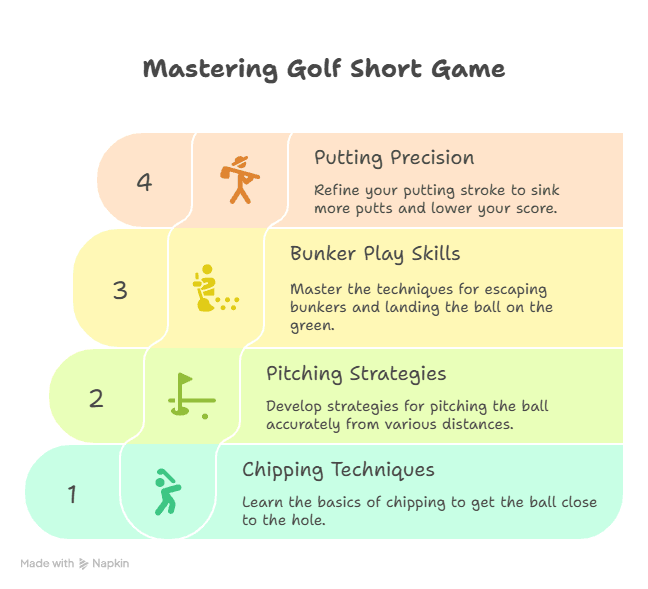
This change is not only about lowering your score; it's also about making your time on the course better overall. Many people find golf irritating since there are so many things that can affect it, such the weather, the course layout, and even that one friend who always wants to give you advise when you don't want it! But if you work on your short game, those modest wins add up rapidly. Instead than thinking about missed chances from far away, you'll celebrate each good chip or pitch.
Also, getting better at your short game can make your rounds go faster because you'll spend less time looking for balls that got lost in hazards or having trouble with long putts. You'll feel like you did something good when you leave the course, not like you lost. It's like leaving the stage after singing that high note at karaoke night. And let's be honest: who doesn't want to have more good times with pals over drinks after a round? So enjoy this trip to getting better at your short game. It could make golf one of your favorite things to do!
The most important thing is to practice. Repetition is important for everything in life, from learning to ride a bike to getting that pancake flip just right. You don't have to spend a lot of time at the driving range. Just 20 minutes of practice on chips and pitches can make a big difference.
Famous Quotes:
1. On Short Game Mastery:
– “The short game is where you can save strokes and build confidence.” — Phil Mickelson
2. On Importance of Short Game:
– “You drive for show, but you putt for dough.” — Bobby Locke
3. On Skills Around the Green:
– “The most important shot in golf is the next one.” — Ben Hogan (implying that mastering each shot, especially around the green, is crucial)
4. On Practice and Improvement:
– “Golf is a game of skill and strategy, and the short game is where those elements come together.” — Jack Nicklaus
5. On Enjoyment Through Mastery:
– “It's not about how far you hit it; it's about how well you can get it up and down.” — Gary Player
Chipping: The Art of Precision
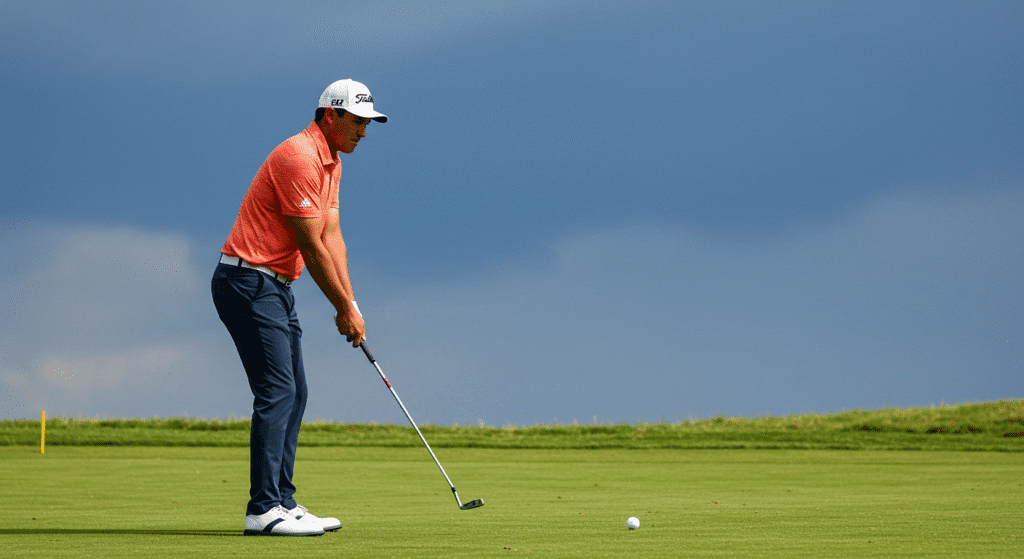
Now let's speak about chipping, which is the skill of getting that little ball onto the green as smoothly as you can. Imagine standing just off the edge and seeing that hole glaring back at you like it knows something you don't! The right stance and grip are the first steps to a good chip shot. Your feet should be close together, and most of your weight should be on your front foot. This is similar to how you might balance on one leg in an awkward yoga pose.
Try using different clubs to become used to chipping. Some people swear by their pitching wedge every time, but trying out different clubs can help you hit the ball farther and in new ways. It's like trying out several ice cream flavors before settling on vanilla! A 9-iron might help you hit lower chips, and a sand wedge might give you the additional loft you need for tough lies.
Speaking of lies, be careful where your ball lands! It's like the part in a scary movie when the unknowing person walks into the dark chamber. You think you're safe, but suddenly bang! Your golf ball ends up in dense grass or next to something like a tree root. It seems like nature is working against us golfers, planning our doom with every swing.
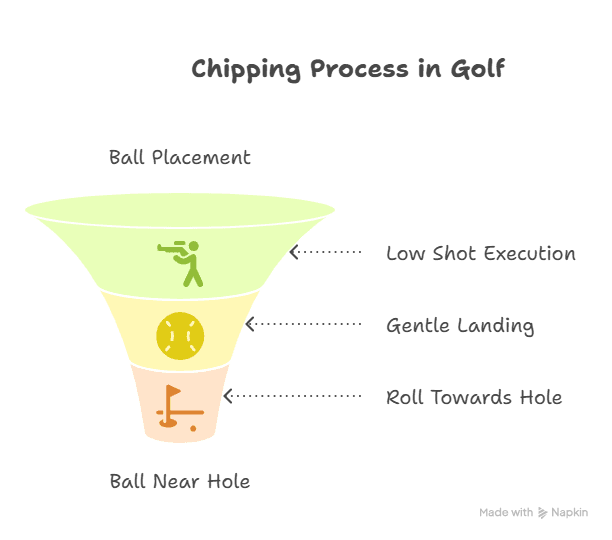
It's important to change your technique when you discover your ball in less-than-ideal conditions. You might have to change your swing if you hit into the thick grass, which is often called “the rough.” The grass can get a hold of your clubface and make it far less accurate and far. So instead of trying to break through it like you're trying out for “American Ninja Warrior,” think about taking a more measured approach. You might want to choke down on the club a little and execute a shorter backswing. This will help you hit the ball solidly instead of just sending clumps of grass flying.
Now, let's talk about those annoying things that get in the way, like tree roots or pebbles. If your ball gets stuck up against one of these beauties, it can feel like Mother Nature is giving you the finger. But don't lose hope! Instead of freaking out and swinging wildly in anger (which I may or may not have done once or twice), take a minute to think about what you can accomplish. If you don't have a lot of space, you might need to use a punch shot, which is a low trajectory shot that aims to get beneath branches while still moving toward the green.
It's also crucial to know that sometimes it's best to be safe. If striking from that bad lie could end in disaster (such breaking clubs or being caught on camera doing something embarrassing), you might want to take an unplayable lie penalty instead. It hurts a little to add strokes to your scorecard, but at least you won't have to tell your buddies about how you tried to hit through a tree trunk!
So, the next time you're out there fighting both man-made and natural dangers, keep in mind that you should change your tactics dependent on where that sly little ball lands! Take on the challenge because isn't it exciting to go through tough situations like these? And who knows, you might even get some funny stories to tell over drinks after the round!
Here are some quotes specifically related to “Chipping: The Art of Precision” from known authors:
1. On the Importance of Chipping:
– “Chipping is one of the most important parts of the game, and it's often overlooked.” — Tom Watson
2. On Precision in Chipping:
– “The key to chipping is to keep it simple and focus on your technique.” — Phil Mickelson
3. On Practice and Mastery:
– “Practice your short game as if your life depended on it; that's where you will save strokes.” — Ben Hogan
4. On Mental Approach:
– “In chipping, confidence is key; visualize success before you execute.” — Annika Sörenstam
5. On Technique and Control:
– “A good chip shot requires a delicate touch and a precise mindset.” — Seve Ballesteros
Pitching: Getting Airborne

Now let's talk about pitching, which is when we want our ball to fly gracefully through the air before resting softly on the green, like a majestic bird flying over its territory. When you pitch, you usually need more loft than when you chip because you're trying to hit a longer distance instead of just hitting the target.
Before you take a pitch shot, check your setup again. Your feet should be shoulder-width apart, and most of your weight should still be on your front foot (you see a pattern here!). This position not only keeps you stable, but it also helps you keep control of the shot. Think of yourself as a superhero ready to save the day. You should stand tall and confident, not too wide like you're trying to do the splits, and definitely not so narrow that you feel like you're going to fall over at any time.
Now, let's talk about the swing, which is really crucial. The most important thing is to be fluid. Instead of flailing around, think of it as a lovely ballet motion. You want your movement to look like someone saying goodbye to a friend across the street, not like someone swinging wildly at piñatas at a birthday party. Yes, I've been there, swinging like crazy and then realizing I'm producing more mess than magic! When you swing smoothly, you can hit the ball better, which is very important when you have to make those delicate pitch shots.
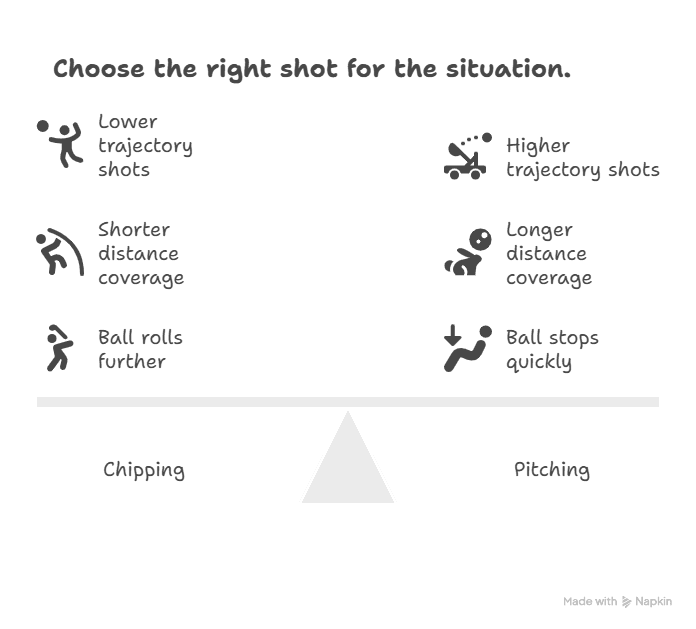
When you start your backswing, let your arms and shoulders work together. You shouldn't feel stiff or forced. Instead, think of it as drawing back on a rubber band. There is tension but no strain. As you start your downswing, pay attention to how you smoothly move your weight from your front foot to your back foot and then back to your front foot again into impact. This transfer of weight will help you get just the right amount of power while yet keeping everything under control.
Let's not forget about where you're aiming when we talk about control! Before you even swing the club back, you should know what your target is. Imagine you're throwing a dart at a bullseye instead of throwing spaghetti against the wall and praying it sticks! Seeing the path can mean the difference between landing softly on the green and sending it blasting off into space.
And don't forget about follow-through; it's just as crucial as what happens before impact. After you hit the ball, let your club continue to move up and out toward the target you were aiming for. This follow-through makes sure you've fully committed to the shot and makes it more accurate.
So the next time you're getting ready for that pitch shot, keep in mind that the setup is important, that you should swing smoothly like you're saying goodbye (but not forever), that you should focus on your goal, and that you should finish hard! With practice—and maybe a little bit of humor—you'll soon be able to handle those tough short game scenarios like a pro!
As always, and I can't stress this enough, practice makes perfect! Practice different distances and lays until hitting those gorgeous pitch shots comes naturally. And don't forget: things don't always go as planned. Don't worry about it; we've all been there!
Here are some quotes related to “Pitching: Getting Airborne” in golf:
1. On the Importance of Pitching:
– “The pitch shot is the most difficult shot in golf, but it's also the one that can save you the most strokes.” — Jack Nicklaus
2. On Technique and Execution:
– “To master pitching, you must learn to control your trajectory and spin; that's where the magic happens.” — Phil Mickelson
3. On Confidence in Pitching:
– “When you stand over a pitch shot, believe that you can execute it perfectly; confidence is half the battle.” — Annika Sörenstam
4. On Practice and Skill Development:
– “Great pitching comes from relentless practice and a willingness to learn from every shot.” — Ben Hogan
5. On Strategy in Pitching:
– “Every pitch shot should be approached with strategy; know your landing area and trust your instincts.” — Seve Ballesteros
Putting: The Final Frontier
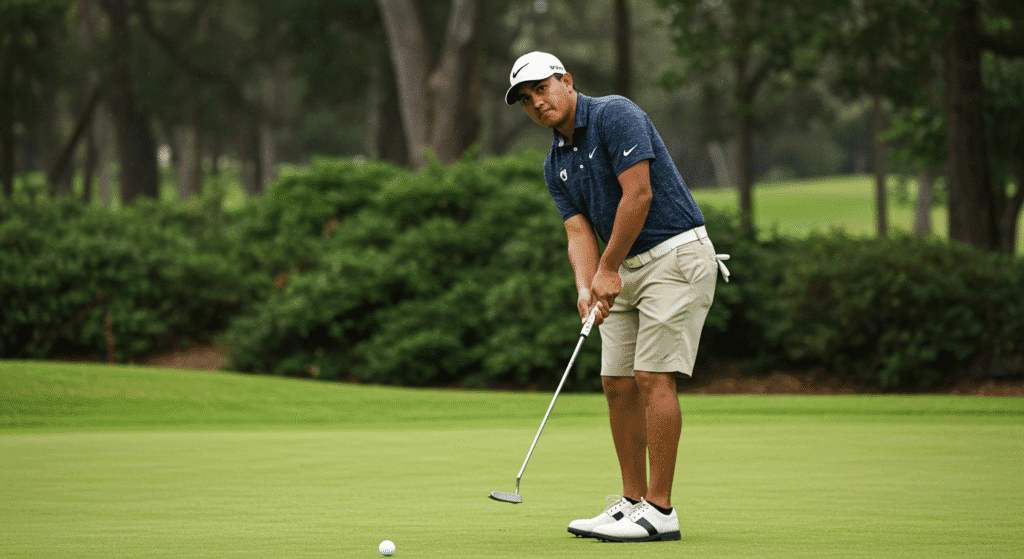
Ah yes, putting—the time when all of your practice comes together in one beautiful try to sink that small white ball into its own sweet home (the hole). To be honest? Putting might sometimes feel like doing brain surgery under pressure, so don't worry! With some focused effort, patience, and persistence (and maybe some good luck), you'll also get really good at reading greens.
To have a good putting stance, you need to bend slightly forward and keep your feet shoulder-width apart. You guessed it! This position is very important because it helps you stay balanced and in control during the stroke. Think of it as getting ready for a show. If you move around like a toddler attempting to walk in shoes that are too big, you might not achieve the results you desire. Instead, try to stand up straight and confidently so that you feel ready to sink the putt.
Now, let's get into the specifics of how you should place your upper body. Your shoulders should be relaxed, but they should be lined up with your target line. It's almost like they're giving you a friendly nod in the direction you want the ball to go—no pressure! And then there are your eyes, which are the most important part of this whole placing thing. You also want them to be right over the ball so that they are more aligned. No one wants their putt to go off course like a shopping cart that goes the wrong way in a grocery store aisle. We've all been there: pushing that cart straight just to have it unexpectedly turn left when you least expect it!
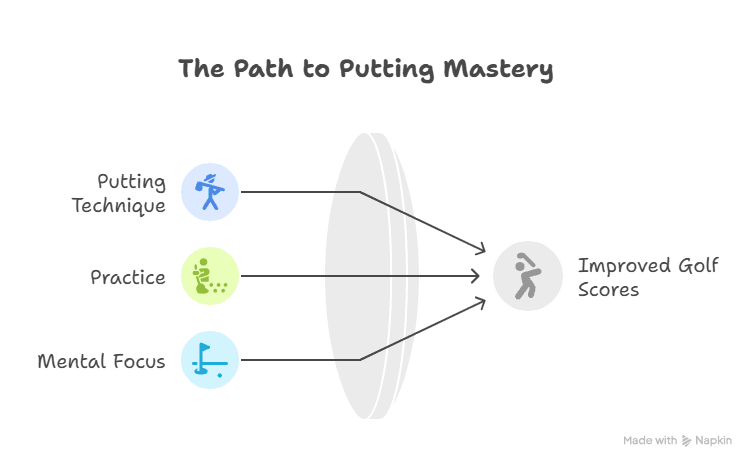
Picture an invisible line going from your ball to the hole to help you line things up. This picture in your head can help you set up and make it clear where you're targeting. But don't just stand there like a statue; take a breath! Before you make your stroke, take a minute to relax your shoulders and clear your mind. Golf is as much about being mentally focused as it is about being physically skilled, so let go of whatever problems or distractions you may have.
When you're ready to putt, hold the club lightly yet firmly. Think of holding a little bird instead of pressing it strongly (no one wants an angry bird!). A light grip makes it easier to feel and touch during the stroke. When you start your backswing, keep in mind that smoothness is also important! The movement should be smooth, not jerky or hasty, like when you're carefully pulling back on a bowstring before letting an arrow fly.
What about the actual putting motion? Imagine swinging your arms like a pendulum while keeping everything else still. Your shoulders will perform most of the work here. Let them move the club back and through without moving too much of your body. It's like dancing with just the right amount of flair so it doesn't turn into an embarrassing flail-fest!
Last but not least, remember to follow through! The way you finish putting is just as important as the way you finish pitch shots. Letting the club keep going after contact shows that you really want to make that shot. Who knows? That little bit of more speed can be all it takes to get your ball into the cup.
So, the next time you're about to make a big putt, remember these things: get a good stance, line up your eyes perfectly above the ball, take a deep breath to stay cool and focused, and then do it with confidence! It won't be long before you realize how much fun it can be to sink those putts if you practice and are patient (and maybe even giggle a little along the way).
It's also important to talk about grip pressure. It should be light yet strong enough to keep everything from slipping away during the swing. Instead of hitting the ball hard, picture rolling it toward its target. This takes me back to my main point: smoothness always prevails!
Here are some quotes from well-known figures related to “Putting: The Final Frontier” in golf:
1. On the Importance of Putting:
– “Putting is like wisdom — partly a matter of age and experience.” — Arnold Palmer
2. On the Mental Game of Putting:
– “The most important shot in golf is the next one, but the most important putt is always the last one.” — Gary Player
3. On Practice and Precision:
– “You have to be able to think on your feet when you're putting; it's about finding that perfect rhythm.” — Phil Mickelson
Practice Makes Perfect
I hope I've convinced you by now that practicing every part of your short game is really important! Whether you're out there practicing by yourself or with friends in friendly competitions (with snacks!), make sure every session helps you get better, even if it's just a little bit.
One amusing thing that has helped me is Set targets for particular areas that require attention, like cutting down on three-putts each round by one stroke each week or improving chip accuracy over time within certain yardages. This keeps things exciting!

And don't forget: it takes more than a day—or perhaps ten years—to become Tiger Woods. Accept that you will make mistakes along the way. They will help you get better at what you do. Also, they make great stories later!
Golf is unusual from many other sports since you may practice in a lot of various settings, like driving ranges, putting greens, and even on the course. Golfers can modify how they practice to work on specific skills or situations that are hard for them, which makes each session useful in its own way.
Here are some quotes related to “Putting: Practice Makes Perfect” from well-known figures in golf:
1. On the Necessity of Practice:
– “The more I practice, the luckier I get.” — Gary Player
2. On Mastering the Short Game:
– “You can't putt well if you don't practice putting.” — Ben Hogan
3. On Consistency Through Repetition:
– “It's not about how good you are; it's about how much you practice.” — Phil Mickelson
Conclusion: Enjoying Your Time on Course
But in the end? The most important element about any golf experience is having fun, even if you're practicing on your short game skills to get better. It's not just about the numbers on the scorecard or how low you can get your handicap. It's about those great times outside when you may take in the fresh air and see how beautiful nature is. What could be better than standing on a green that is bathed in sunlight, listening to the birds sing, and feeling the cool breeze blow through your hair?
Now, let's talk about what makes golf so special: it's the mix of mental and physical effort. You are definitely getting a workout by swinging clubs and walking miles, but there is also something relaxing about it all. Every swing is a chance to clear your mind and connect with what's going on around you. Have you ever noticed that each hole has its own view? One minute you're looking at tall trees, and the next you're attempting to go around a hard water danger. It's like a theme park in the wild!
And because we're talking about connection, think about how golf brings people together. Whether you're giving your friends suggestions during a game or chatting with people in your group, these kinds of experiences build memories that last. When I'm on the course, I remember that it's not only about beating my last score; it's also about having fun and making new friends. When you celebrate with other people, the joy of making that perfect putt is much greater.
Don't get me wrong; it's important to focus on your short game. It can make rounds that are hard into rounds that are pleasant. But don't lose sight of the big picture. Instead of fretting over every missed shot or lousy chip, try to enjoy each small triumph along the way. It takes time to become an expert. Did you finally get that flop shot right that you've been practicing? Throw a party! Did you not three-putt on that hard green? Give yourself a high five!
Factoid: The 19th Hole Tradition: Meeting up in the clubhouse, or “19th hole,” after a game of golf is a tradition that goes beyond merely having drinks; it's also a big part of the fun. A lot of players say that talking about the day's round with friends over a drink makes the game more fun and gives them a chance to think about both the good and bad things that happened during the game.
It's amazing that this point of view enables you go forward without feeling like you have to do everything at once. Things might go more smoothly if you quit thinking about being flawless and start having fun instead. It's like hitting the sweet spot on your driver after a lot of swings!
As you start along this path to become better at your short game (and more), take a moment to enjoy everything about golfing life, from the beautiful views around each tee box to the deep connections you make with other players on the fairways. In the end, it's these moments—the happiness shared between friends and the beautiful sunsets that change the color of the sky—that will stay with us long after we've put away our clubs for the day.
In short? Have fun with every part of this great game we call golf! It's not just about getting better; it's also about having fun while you chase it in nature's splendor, since that's where the true fun is!
When someone says “golf short game,” don't roll your eyes and think it's only for old pros who are bored. It's where real magic happens right in front of us… Believe me when I say that there's nothing like seeing the ball roll gently into its cozy little hole after all the work that went into it!
Featured Snippet: The short game is where golf scores are truly won. By mastering chipping, pitching, and putting, players can lower scores, gain confidence, and enjoy the game more. Consistent practice, proper setup, and patience help transform missed shots into smooth strokes and frustration into satisfaction on the green.
Frequently Asked Questions
What is considered the short game in golf?
The short game refers to all shots played from about 100 yards or less from the hole. It includes chipping, pitching, bunker shots, and putting—skills that require finesse rather than power.
Why is the short game so important?
Mastering the short game saves strokes quickly. It helps players recover from mistakes, make more pars and birdies, and dramatically lower overall scores.
How can I improve my chipping accuracy?
Use a narrow stance, lean slightly forward, and strike down on the ball with control. Practicing different clubs and distances improves precision around the green.
What’s the key to better pitching?
Focus on smooth tempo and consistent weight transfer. A relaxed swing, proper loft selection, and a clear target line help your pitch shots land softly and accurately.
How can I become more consistent at putting?
Adopt a steady stance, keep your eyes directly over the ball, and swing your shoulders like a pendulum. Smooth, confident strokes lead to better distance control and accuracy.
How often should I practice my short game?
Even 20 minutes a few times a week can make a difference. Short, focused sessions on chipping and putting build muscle memory and confidence over time.
What’s the biggest mindset tip for short game success?
Stay calm, visualize the shot, and embrace small improvements. Patience and positivity turn pressure into focus and make the game more enjoyable.
Suggested Resources
Short Game Secrets Every Golfer Should Know
https://www.golfdigest.com/story/short-game-secrets-every-golfer-should-know
The Importance of The Short Game in Golf
https://www.golf.com/instruction/2021/02/12/the-importance-of-the-short-game-in-golf/
How To Improve Your Chipping Skills
https://www.pga.com/story/how-to-improve-your-chipping-skills

Kevin Collier is an avid golfer and contributing author at AIGolfTips.com, where he shares his passion for the game through expert tips, techniques, and gear reviews. With years of experience on the course, Kevin offers valuable insights for golfers of all skill levels, helping them improve their game and maximize their potential. Whether discussing swing mechanics or the latest in golf technology, Kevin's engaging approach aims to inspire and educate fellow golf enthusiasts to elevate their performance and enjoy every moment on the green.





